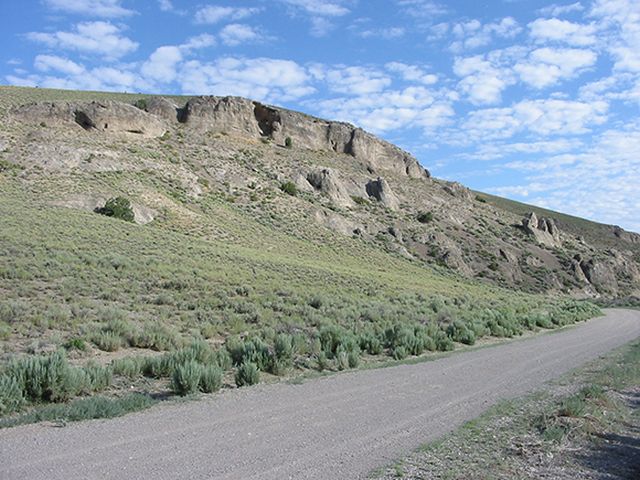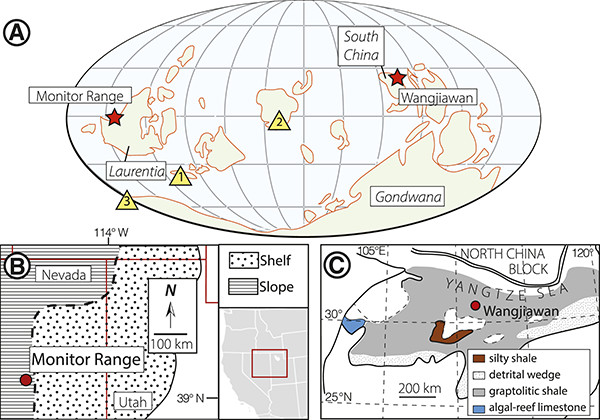
by Izze Siemann Wednesday, November 15, 2017

Researchers found mercury concentration spikes in Late Ordovician rock sampled from this site in Nevada's Monitor Range, indicating a possible role for large-scale volcanic activity in a mass extinction roughly 444 million years ago. Credit: David S. Jones
During the Ordovician, between about 488 million and 444 million years ago, plant life first emerged on land, while primitive fish and a variety of marine invertebrates flourished in the oceans. Toward the end of the period, however, a mass extinction — the first of the so-called “Big Five” Phanerozoic extinctions — wiped out roughly 60 percent of all marine invertebrate genera. In a recent study, researchers shed new light on a possible cause of the Late Ordovician extinction: volcanic activity.
What led to the extinction has long been a topic of debate among scientists. Around the end of the Ordovician, Earth underwent two periods of widespread glaciation, each of which caused drop sea levels to and led to the disappearance of shallow seas that provided optimal conditions for a variety of organisms. The cooling climate and dropping seas, along with decreasing oxygenation of the oceans, could have been “the major driver of extinction,” says Seth Finnegan, a paleontologist at the University of California, Berkeley, who studies the Late Ordovician extinction and was not involved in the recent study.
Other possible causes have been suggested as well, however. In a 2014 study published in Gondwana Research, researchers noted that widespread oceanic euxinia, when seawater has both low oxygen levels and high sulfide levels, “together with habitat destruction caused by plate tectonic movements,” could have contributed to the extinction. In the new study, published in Geology, David Jones, a geologist at Amherst College, and his colleagues raised the possibility that substantial amounts of volcanism could have also played an important role.
In recent years, scientists have found spikes in mercury abundance in rocks associated with eruptions of large igneous provinces (LIPs), which are emplaced by massive prolonged magmatic eruptions. Many of Earth’s mass extinctions, such as the end-Permian, end-Triassic and end-Cretaceous extinctions, have been correlated in time with LIPs. In fact, some scientists argue that LIPs may be the key commonality among all mass extinctions on Earth, Jones says. However, to date, the Late Ordovician extinction has not been associated with a LIP, leading Jones and his colleagues to look for a volcanic connection.

A paleogeographic reconstruction showing the locations, 446 million years ago, of the studied sites (red stars in A), as well as the locations of Late Ordovician volcanic rocks that might have been produced by the eruption of a large igneous province. Credit: Jones et al., Geology, 2017
Analyzing samples of Late Ordovician rock collected from the Monitor Range in Nevada and from near Wangjiawan, China, Jones and his team looked for evidence of such a connection. “We were surprised to see a very notable increase in mercury content at a few different places … associated with the extinction,” Jones says, which suggests that volcanic activity contributed to the Late Ordovician mass extinction.
The team also investigated how large-scale eruptions might have affected the glaciations that occurred at the time. Based on computer modeling of climate and geochemical cycling during the Ordovician, and the overlap between the timing of mercury deposition and glaciation observed in the rock samples, they concluded that a LIP eruption could have contributed to both long- and short-term climate change at the end of the Ordovician.
Volcanic eruptions release carbon dioxide, but over millions of years, the eruption of a LIP could actually “remove enough carbon dioxide out of the atmosphere — as a result of chemical weathering of freshly erupted and active basalt — to cool the planet enough that glaciers would expand,” Jones says.
A second volcanic process potentially linking a LIP to the cooling climate of the Late Ordovician, Jones says, is the eruption of large amounts of sulfur aerosols, tiny particles that reflect incoming sunlight back into space. The effects of sulfur aerosols on climate are shorter-lived compared to carbon dioxide, as they have shorter residence times in the atmosphere. But with each eruptive burst from a LIP, sulfur aerosols would have increased Earth’s reflectance, or albedo, and could have contributed to the global cooling that led to the glaciation events associated with the Ordovician extinction.
Despite the results of the new study, the connection between LIP volcanism and the Late Ordovician mass extinction is far from settled. It is vital, for example, “to know how unusual those [mercury] enrichments are,” Finnegan says, and whether high concentrations similar to those seen in the new study could arise in the rock record through other processes. “I don’t think anybody knows a lot about how mercury gets altered by post-depositional [chemical transformations],” he says.
Various processes, such as diagenesis — the conversion of sediment to rock — and microbial activity, can redistribute elements in sediments and rocks, altering original geochemical signals of surface processes such as LIP eruptions. “The worry would be that there’s something that happens during the process of chemical reorganization of rocks by which low levels of ambient mercury … get concentrated into particular minerals,” Finnegan says. And if “you get a pocket of those minerals in your sample,” the data the sample provides can be misleading.
With numerous existing theories about the cause of the Late Ordovician extinction, piecing together the correct scenario is no small challenge. And it’s possible that multiple different processes and factors each contributed. “We could all be focusing on aspects of the same underlying story,” Finnegan says.
Jones’ team plans to next investigate whether similar mercury patterns are seen in additional rock samples from around the planet that date to the Late Ordovician extinction, and to study how mercury accumulates and is preserved and altered in ancient rock.
Meanwhile, a team led by Jones’ colleague, Kunio Kaiho of Tohoku University in Japan, who was a co-author on the current study, is now studying the second major Phanerozoic mass extinction, which occurred between about 375 million and 360 million years ago in the Late Devonian, to understand its fundamental causes and determine if was also linked to a LIP.
© 2008-2021. All rights reserved. Any copying, redistribution or retransmission of any of the contents of this service without the expressed written permission of the American Geosciences Institute is expressly prohibited. Click here for all copyright requests.